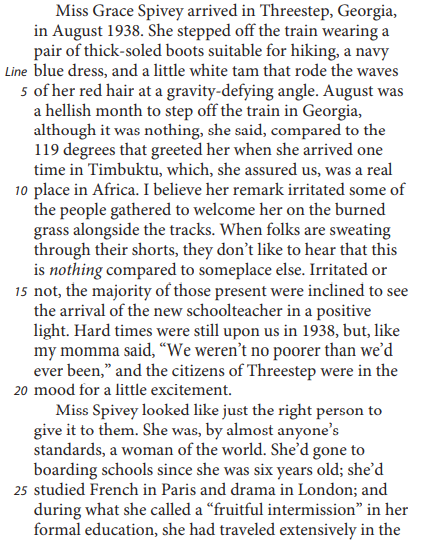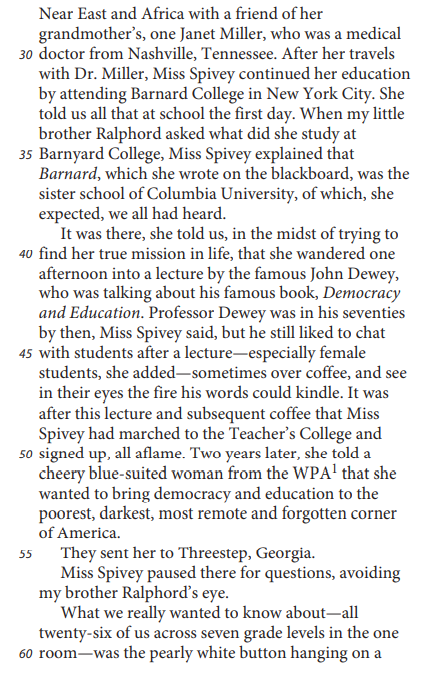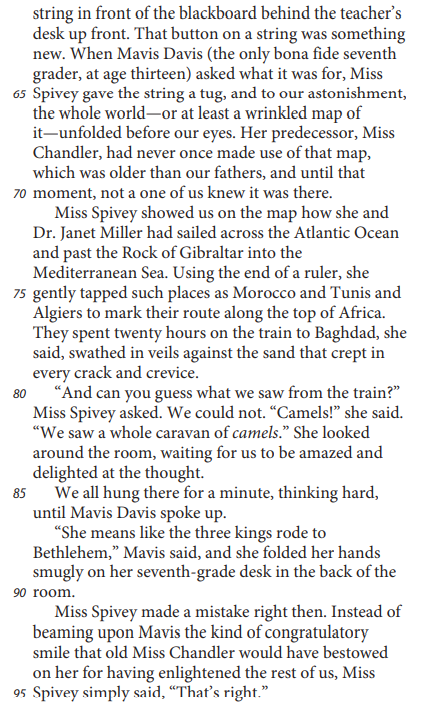SAT (Scholastic Assessment Test) is a standard test, used for taking admission to undergraduate programs of universities or colleges of the United States. SAT is developed and published by the College Board, an organization in the United States, administered by the Educational Testing Service. In this article of AKVTutorials, you will get SAT Practice Reading Passage Test 46 | SAT 2024 Online Tutor AMBiPi.
SAT Reading Practice Passage
This passage is adapted from Mary Helen Stefaniak, The Cailiffs of Baghdad, Georgia: A Novel. ©2010 by Mary Helen
Stefaniak.



SAT Reading Comprehension Practice Test Questions
SAT Practice Test 46 Question No 1
The narrator of the passage can best be described as
Option A: one of Miss Spivey’s former students.
Option B: Miss Spivey’s predecessor.
Option C: an anonymous member of the community.
Option D: Miss Spivey herself.
SAT Practice Test 46 Answer No 1
Show/Hide Answer
Option A :
Throughout the passage, the narrator refers to Miss Spivey’s 1938 class as “we” and “us” and describes interactions between Miss Spivey and her students as a firsthand observer, indicating that the narrator was a member of this 1938 class. Therefore, the narrator of the passage can best be described as one of Miss Spivey’s former students.
Choice B is incorrect because the narrator refers to Miss Spivey’s predecessor, Miss Chandler, by name, not as “I” or “me,” and therefore the narrator isn’t Miss Spivey’s predecessor. Choice C is incorrect because the passage identifies the narrator as a member of Miss Spivey’s 1938 class and also mentions the narrator’s mother and brother, Ralphord. Choice D is incorrect because the narrator refers to Miss Spivey by name and as “she” and “her,” not as “I” or “me,” and thus can’t be Miss Spivey herself.
SAT Practice Test 46 Question No 2
In the passage, Three step is mainly presented as a
Option A: summer retreat for vacationers.
Option B: small rural town.
Option C: a town that is home to a prominent university.
Option D: comfortable suburb.
SAT Practice Test 46 Answer No 2
Show/Hide Answer
Option B :
The description of the train’s arrival in the first paragraph suggests that Threestep is a rural town: instead of a paved platform, the tracks are lined with “burned grass.” Meanwhile, the description of the school in the sixth paragraph implies that the community is small: instead of individual rooms for separate grade levels, the school’s single room contains twenty-six students spread “across seven grade levels.” Therefore, Threestep is mainly presented in the passage as a small rural town.
Choice A is incorrect because the narrator describes Threestep as uncomfortably hot for its residents, not as a summer retreat for vacationers. Choice C is incorrect because Miss Spivey refers to prominent universities located in other cities, not ones located in Threestep. Choice D is incorrect because in the first paragraph Threestep is characterized as a small rural town that is experiencing “hard times,” not as a comfortable suburb.
SAT Practice Test 46 Question No 3
It can reasonably be inferred from the passage that some of the people at the train station regard Miss Spivey’s comment about the Georgia heat with
Option A: sympathy, because they assume that she is experiencing intense heat for the first time.
Option B: disappointment, because they doubt that she will stay in Threestep for very long.
Option C: embarrassment, because they imagine that she is superior to them.
Option D: resentment, because they feel that she is minimizing their discomfort.
SAT Practice Test 46 Answer No 3
Show/Hide Answer
Option D :
In the first paragraph, Miss Spivey remarks that the heat in Georgia is nothing compared to the heat she experienced in Timbuktu. Later in this paragraph, the narrator states, “I believe her remark irritated some of the people gathered to welcome her on the burned grass alongside the tracks. When folks are sweating through their shorts, they don’t like to hear that this is nothing compared to someplace else.” Hence it can reasonably be inferred from the passage that some of the people at the train station regard Miss Spivey’s comment about the Georgia heat with resentment because they feel that she is minimizing their discomfort.
Choice A is incorrect because Miss Spivey informs the people at the train station that she has experienced even more extreme heat, so they wouldn’t have assumed that she is experiencing intense heat for the first time. Choice B is incorrect because the passage indicates that the people at the station know Miss Spivey is coming to Threestep to work, not that they doubt she will stay there very long. Choice C is incorrect because the passage doesn’t indicate that the people at the train station imagine that she is superior to them.
SAT Practice Test 46 Question No 4
Which choice provides the best evidence for the answer to the previous question?
Option A: Lines 2-5 (“She stepped… angle”)
Option B: Lines 10-14 (“I believe… else”)
Option C: Lines 14-20 (“Irritated… excitement”)
Option D: Lines 23-25 (“She’d gone… London”)
SAT Practice Test 46 Answer No 4
Show/Hide Answer
Option B :
The previous question asks what can be inferred from the passage about the reaction of the people at the train station to Miss Spivey’s comment about the Georgia heat. The answer, that it can be reasonably inferred from the passage that some of the people at the train station regard Miss Spivey’s comment about the Georgia heat with resentment because they feel that she’s minimizing their discomfort is best supported in the first paragraph: “I believe her remark irritated some of the people gathered to welcome her on the burned grass alongside the tracks. When folks are sweating through their shorts, they don’t like to hear that this is nothing compared to someplace else.”
Choices A, C, and D are incorrect because the cited lines don’t provide the best evidence for the answer to the previous question. Instead, they describe Miss Spivey’s appearance (choice A), reflect on why people viewed her arrival positively despite their irritation over her remark (choice C), and outline her education (choice D).
SAT Practice Test 46 Question No 5
Miss Spivey most likely uses the phrase “fruitful intermission” (line 26) to indicate that
Option A: she benefited from taking time off from her studies to travel.
Option B: her travels with Janet Miller encouraged her to start medical school.
Option C: her early years at boarding school resulted in unanticipated rewards.
Option D: what she thought would be a short break from school lasted several years.
SAT Practice Test 46 Answer No 5
Show/Hide Answer
Option A :
In the second paragraph, Miss Spivey describes a break she took from her formal education as a “fruitful intermission.” She explains that she “traveled extensively in the Near East and Africa with a friend of her grandmother’s, one Janet Miller” during this time. Therefore, Miss Spivey most likely uses the phrase “fruitful intermission” to indicate that she benefited from taking time off from her studies to travel.
Choice B is incorrect because Miss Spivey’s use of the phrase “fruitful intermission” doesn’t indicate that her travels with Janet Miller encouraged her to start medical school. Choice C is incorrect because Miss Spivey uses the phrase “fruitful intermission” to refer to a break in her formal education after boarding school, not during her early years there. Choice D is incorrect because Miss Spivey’s use of the phrase “fruitful intermission” doesn’t indicate that this break lasted longer than she had expected.
SAT Practice Test 46 Question No 6
The interaction between Miss Spivey and Ralphord serves mainly to
Option A: suggest that Miss Spivey has an exaggerated view of what information should be considered common knowledge.
Option B: establish a friendly dynamic between the charming schoolchildren and their indulgent and doting new instructor.
Option C: introduce Ralphord as a precocious young student and Miss Spivey as a dismissive and disinterested teacher.
Option D: demonstrate that the children want to amuse Miss Spivey with their questions.
SAT Practice Test 46 Answer No 6
Show/Hide Answer
Option A :
In the second paragraph, Miss Spivey tells her class that she went to Barnard College in New York City, which prompts Ralphord to ask her what she studied at “Barnyard College.” In response, Miss Spivey explains that Barnard College “was the sister school of Columbia University, of which, she expected, we all had heard.” This interaction implies that, contrary to Miss Spivey’s expectations, the names of prestigious East Coast schools aren’t common knowledge among her pupils. Thus the interaction between Miss Spivey and Ralphord serves mainly to suggest that Miss Spivey has an exaggerated view of what information should be considered common knowledge.
Choice B is incorrect because the interaction between Miss Spivey and Ralphord establishes an atmosphere of misunderstanding, not friendliness. Choice C is incorrect because Ralphord’s question demonstrates his naivety rather than his precociousness. Choice D is incorrect because the passage doesn’t suggest that Ralphord’s question is an attempt to amuse Miss Spivey.
SAT Practice Test 46 Question No 7
In the third paragraph, what is the narrator most likely suggesting by describing Miss Spivey as having “wandered” (line 40) in one situation and “marched” (line 49) in another situation?
Option A: Dewey, knowing Miss Spivey wasn’t very confident in her ability to teach, instilled in her a sense of determination.
Option B: Talking with Dewey over coffee made Miss Spivey realize how excited she was to teach in the poorest, most remote corner of America.
Option C: After two years spent studying, Miss Spivey was anxious to start teaching and be in charge of her classroom.
Option D: Miss Spivey’s initial encounter with Dewey’s ideas was somewhat accidental but ultimately motivated her to decisive action.
SAT Practice Test 46 Answer No 7
Show/Hide Answer
Option D :
The third paragraph describes Miss Spivey as having “wandered,” or walked aimlessly, into a lecture by John Dewey. Following her interactions with the professor, Miss Spivey was inspired to work as an educator; consequently, she “marched,” or walked purposefully, to sign up for the Teacher’s College. Hence, by describing Miss Spivey as having “wandered” in the former situation and “marched” in the latter, the narrator is most likely suggesting that Miss Spivey’s initial encounter with Dewey’s ideas was somewhat accidental but ultimately motivated her to decisive action.
Choices A and C are incorrect because the narrator’s description of Miss Spivey as having “wandered” into Dewey’s class and “marched” to sign up for the Teacher’s College suggests that her accidental encounter with him motivated her to begin studying to be a teacher, not that Dewey saw Miss Spivey as lacking confidence in her ability to teach (choice A) or that she was anxious to be in charge of her classroom (choice C). Choice B is incorrect because Miss Spivey didn’t express a desire to teach in the poorest, most remote corner of America until two years after talking with Dewey over coffee.
SAT Practice Test 46 Question No 8
According to the passage, Miss Spivey ended up in Threestep as a direct result of
Option A: her friendship with Janet Miller.
Option B: attending college in New York City.
Option C: talking with a woman at the WPA.
Option D: Miss Chandler’s retirement from teaching.
SAT Practice Test 46 Answer No 8
Show/Hide Answer
Option C :
According to the third paragraph, after two years at the Teacher’s College, Miss Spivey told a woman from the WPA that “she wanted to bring democracy and education to the poorest, darkest, most remote and forgotten corner of America. Consequently, “they sent her to Threestep, Georgia,” according to the fourth paragraph. Thus Miss Spivey ended up in Threestep as a direct result of talking with a woman at the WPA.
Choices A and B are incorrect because Miss Spivey ended up in Threestep as a direct result of talking with a woman at the WPA, not as an immediate consequence of her friendship with Janet Miller (choice A), or her decision to attend college in New York City (choice B). Choice D is incorrect because Miss Chandler is mentioned as Miss Spivey’s predecessor in Threestep, but Miss Spivey’s arrival in town doesn’t occur as a direct result of Miss Chandler’s retirement.
SAT Practice Test 46 Question No 9
In the passage, when Miss Spivey announces that she had seen camels, the students’ reaction suggests that they are
Option A: delighted.
Option B: fascinated.
Option C: baffled.
Option D: worried.
SAT Practice Test 46 Answer No 9
Show/Hide Answer
Option C :
The ninth paragraph describes the students’ reaction to Miss Spivey’s announcement that she had seen camels on her trip to Baghdad: “We all hung there for a minute, thinking hard until Mavis Davis spoke up.” Mavis reminds the other students that camels appear in a story they are familiar with. Thus, when Miss Spivey announces that she had seen camels, the students’ reaction suggests that they are baffled.
Choices A, B, and D are incorrect because when Miss Spivey announces that she had seen camels, the students’ reaction suggests that they are baffled, not delighted (choice A), fascinated (choice B), or worried (choice D).
SAT Practice Test 46 Question No 10
Which choice provides the best evidence for the answer to the previous question?
Option A: Lines 82-84 (“She looked… thought”)
Option B: Lines 85-86 (“We all… up”)
Option C: Lines 87-90 (“She means… room”)
Option D: Lines 91-95 (“Instead… right”)
SAT Practice Test 46 Answer No 10
Show/Hide Answer
Option B :
The previous question asks what the students’ reaction suggests about them when Miss Spivey announces that she had seen camels. The answer, that their reaction suggests that they are baffled, is best supported in the ninth paragraph: “We all hung there for a minute, thinking hard until Mavis Davis spoke up.”
Choices A, C, and D are incorrect because the cited lines don’t provide the best evidence for the answer to the previous question. Instead, they describe Miss Spivey’s anticipation of a delighted or amazing response to her announcement that she had seen camels (choice A), relay Mavis’s reference to a story familiar to the students (choice C), and reflect on the subdued nature of Miss Spivey’s response to Mavis (choice D).



